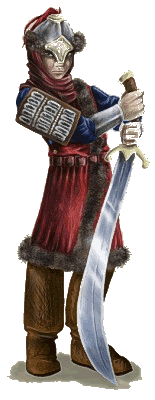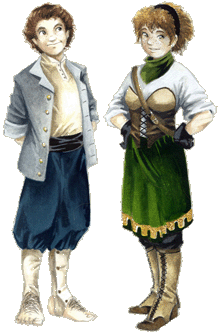|
The History of the Truefolk
The Third Age: Halflings and the Undead War
<<
PREVIOUS • History of
Halflings • NEXT >>
 After
the disastrous Battle of ShadowGuard, emissaries from Ta'Faendryl
were sent to seek out and recruit the fierce tribes of mounted halflings
inhabiting the Northern Steppes. Although the halflings were suspicious
of the tall visitors, ancient custom demanded that they receive
guests with a hospitable, though also wary and standoffish, welcome.
They listened to the Faendryl, and after much discussion, the three
tribes (the Trinity of Truefolk as they called themselves) finally
agreed to ride south as allies to House Faendryl. After
the disastrous Battle of ShadowGuard, emissaries from Ta'Faendryl
were sent to seek out and recruit the fierce tribes of mounted halflings
inhabiting the Northern Steppes. Although the halflings were suspicious
of the tall visitors, ancient custom demanded that they receive
guests with a hospitable, though also wary and standoffish, welcome.
They listened to the Faendryl, and after much discussion, the three
tribes (the Trinity of Truefolk as they called themselves) finally
agreed to ride south as allies to House Faendryl.
The halflings arrived in the aftermath of ShadowGuard, and were
put to the test against the heinous hordes following Despana. For
years they stood with the Elven forces, their own numbers dwindling
as the battles took their toll.
As the united forces of the Elven Nations regrouped for the final
onslaught at Maelshyve, the remnants of the Trinity of Tribes gathered
themselves. By this time some were afoot, having lost their mounts
to the hordes of orcs and ghouls swarming around the horse warriors.
The formation of mounted halflings advanced into the fray, their
flanks guarded by a company of their brethren on foot. Losses were
heavy as the day passed. Then the unexpected occurred. The Faendryl
unleashed their hidden power, leaving the exhausted forces to watch
the carnage as demons ravaged their foes.
|
Since the halflings had, at the time of the Great War
of Undead, no written language, they sang their hereditary
tales to assuage their remorse at the necessity of being away
from their families and ancestral lands for long, harsh years.
Members of other races, hearing the beautiful songs performed
in neighboring camps, listened avidly to the skillful tribal
singers. Thus, Others (as the halflings called all who were
not of the Truefolk) began to remember and learn the songs.
Finally, years later a collected body of music known as the
'Halfling Folk Sagas' were scribed to parchment by the elf
Norl Farar, a work that has enjoyed widespread appreciation
and popularity through the years since the Great War.
|
One might think the battered halflings would have welcomed the
sight of their enemies' demise. However, witnessing the flight of
demons summoned by their supposed Faendryl friends and allies, the
halflings were horrified. As the day ended, effectively concluding
the years-long conflict, the disheartened halflings called a Trine
to resolve their difference of opinion in the aftermath of the bloody
day.
The Trine met. A faction of the group was stricken at the very
concept of having been allied with 'demon summoners'. They felt
they could never return to the Shirelands to face their families.
They argued that they would forever carry the guilt of fighting
for the army that loosed such a travesty on the land and all her
bounty. Others were weary and wished only to return to die in the
Shirelands, hence allowing their souls to find and be reunited with
family and loved ones who had gone before them. It it was Tribal
belief that should one of the Truefolk die in lands far away, they
were doomed after death to wander endlessly, searching for those
they had loved during their lifetime. It was this belief that made
the act of not returning to their families -- advocated by the halflings
who wrestled with the horror conceived at the birth of the demons
-- the supreme sacrifice.
For the first time the Trine was irrevocably split. A third of
the surviving halfling army finally decided to journey north and
west. They were a mixture of all three tribes. The remainder began
the preparations prior to returning home to the Shirelands. The
parting was a tragic one, all believing that they would never be
reunited in either life or death. The choice of who went where fell
not only between Tribes, but between families as well. Those who
didn't return were given the name of Paradis, translated as 'the
Homeless' or 'the Lost' and were never forgotten by the halflings
who finally made it back to their homes in the Shirelands and on
the steppes.
Finally, the Paradis took their leave, and the homeward-bound party
mourned their departure with a weeklong wake, as though they had
just died. During this time, they fasted and sang both the old historical
tales as well as new compositions written for those who had just
left their tents. Some of these songs become timeless examples of
the halfling folk compositions.
 Warriors
returning from ShadowGuard brought with them the stories of the
Undead War, and the heart-wrenching loss of kin. Halflings of all
three tribes were dazed with sorrow. It seemed that every hearth
had an absent loved-one to remember. This was a loss that was nigh
inconceivable, not to mention the problematic fact that so many
extended families were now remnants of what they had once been.
There were more widows and widowers among the Truefolk than had
ever been. Gravestones raised their lonely faces across the Steppes,
however few of the graves below the stones contained a body. It
took years for the tribal elders to convince the Truefolk to move
past the time of mourning for their loved ones. Knowing that the
future of the halfling race depended upon a recovery, the shamans
entreated the tribes to once again embrace the joy of living, a
term--almost forgotten-- that they called 'resch'lative.' Warriors
returning from ShadowGuard brought with them the stories of the
Undead War, and the heart-wrenching loss of kin. Halflings of all
three tribes were dazed with sorrow. It seemed that every hearth
had an absent loved-one to remember. This was a loss that was nigh
inconceivable, not to mention the problematic fact that so many
extended families were now remnants of what they had once been.
There were more widows and widowers among the Truefolk than had
ever been. Gravestones raised their lonely faces across the Steppes,
however few of the graves below the stones contained a body. It
took years for the tribal elders to convince the Truefolk to move
past the time of mourning for their loved ones. Knowing that the
future of the halfling race depended upon a recovery, the shamans
entreated the tribes to once again embrace the joy of living, a
term--almost forgotten-- that they called 'resch'lative.'
The earliest signs of the halfling recovery were seen in the Malghavan
Territories. There, halfling towns gradually regained their populations,
and in time, took possession of the rich fields surrounding the
township. These halflings were a changed group. They no longer felt
the need to wander the lands in search of distant dreams. Instead,
they began to spend more and more effort on the quaint dwellings
that characterized the Shirelands. Round doors eventually dotted
the countryside and verdant gardens made the panorama a thing of
beauty. The halflings migrated less and less and years went by,
however the Trine remained an inalienable institution.
|



 After
the disastrous Battle of ShadowGuard, emissaries from Ta'Faendryl
were sent to seek out and recruit the fierce tribes of mounted halflings
inhabiting the Northern Steppes. Although the halflings were suspicious
of the tall visitors, ancient custom demanded that they receive
guests with a hospitable, though also wary and standoffish, welcome.
They listened to the Faendryl, and after much discussion, the three
tribes (the Trinity of Truefolk as they called themselves) finally
agreed to ride south as allies to House Faendryl.
After
the disastrous Battle of ShadowGuard, emissaries from Ta'Faendryl
were sent to seek out and recruit the fierce tribes of mounted halflings
inhabiting the Northern Steppes. Although the halflings were suspicious
of the tall visitors, ancient custom demanded that they receive
guests with a hospitable, though also wary and standoffish, welcome.
They listened to the Faendryl, and after much discussion, the three
tribes (the Trinity of Truefolk as they called themselves) finally
agreed to ride south as allies to House Faendryl. Warriors
returning from ShadowGuard brought with them the stories of the
Undead War, and the heart-wrenching loss of kin. Halflings of all
three tribes were dazed with sorrow. It seemed that every hearth
had an absent loved-one to remember. This was a loss that was nigh
inconceivable, not to mention the problematic fact that so many
extended families were now remnants of what they had once been.
There were more widows and widowers among the Truefolk than had
ever been. Gravestones raised their lonely faces across the Steppes,
however few of the graves below the stones contained a body. It
took years for the tribal elders to convince the Truefolk to move
past the time of mourning for their loved ones. Knowing that the
future of the halfling race depended upon a recovery, the shamans
entreated the tribes to once again embrace the joy of living, a
term--almost forgotten-- that they called 'resch'lative.'
Warriors
returning from ShadowGuard brought with them the stories of the
Undead War, and the heart-wrenching loss of kin. Halflings of all
three tribes were dazed with sorrow. It seemed that every hearth
had an absent loved-one to remember. This was a loss that was nigh
inconceivable, not to mention the problematic fact that so many
extended families were now remnants of what they had once been.
There were more widows and widowers among the Truefolk than had
ever been. Gravestones raised their lonely faces across the Steppes,
however few of the graves below the stones contained a body. It
took years for the tribal elders to convince the Truefolk to move
past the time of mourning for their loved ones. Knowing that the
future of the halfling race depended upon a recovery, the shamans
entreated the tribes to once again embrace the joy of living, a
term--almost forgotten-- that they called 'resch'lative.'